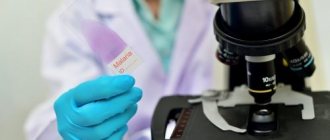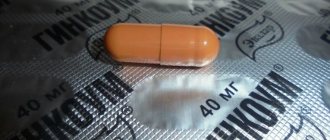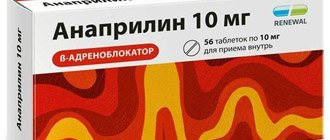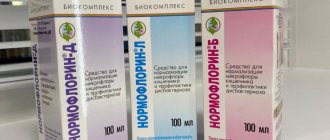Compound
One tablet of Grammidin with the anesthetic Neo contains 3 mg of gramicidin C (used in the form of dihydrochloride), 1 mg of cetylpyridinium chloride (used in the form of monohydrate), 0.2 mg of oxybuprocaine hydrochloride .
In addition, the active components are supplemented with excipients: colloidal silicon dioxide (Aerosil 200), talc, magnesium stearate, acesulfame potassium, mint flavor and sorbitol (Neosorb).
Properties
Gramicidin has a pronounced antibacterial effect. The substance actively affects the most common infectious pathogens in the oral cavity and pharynx. The drug is able to relieve inflammation, eliminate soreness, discomfort when swallowing, and also has a detrimental effect on pathogenic microorganisms.
This is what makes the medical drug “Grammidin” unique.
You will be interested in: “Biovestin Lacto”: instructions for use, purpose and analogues
The anesthetic, which is part of one of the forms of the drug, has an analgesic property and allows you to quickly and effectively eliminate pain in the mouth and throat area. Relief comes almost immediately after the tablet dissolves in the mouth.
Pharmacodynamics and pharmacokinetics
The combined drug includes an antimicrobial component - gramicidin C , an antiseptic - cetylpyridinium chloride and a local anesthetic - oxybuprocaine , which gives an analgesic effect and the drug, in general, is effective for infectious and inflammatory diseases of the oropharynx.
of gramicidin C based on its ability to increase the permeability of the cytoplasmic membranes of microbial cells, causing a violation of the resistance and death of microorganisms (most Gram+ and Gram-).
As a local anesthetic , oxybuprocaine anesthetizes locally on the mucous membrane of the mouth and throat - it acts by reversibly blocking the conduction of nerve signals through the axons (long processes) of nerve cells.
Cetylpyridinium chloride is an antiseptic that inhibits the reproduction and growth of pathogens that cause infectious and inflammatory processes in the mouth and throat.
Thanks to the analgesic effect and antimicrobial effect, inflammation is relieved, discomfort when swallowing is mitigated, and increased salivation promotes natural mechanical cleansing of the throat and oral cavity.
Pharmacokinetics
The drug acts locally, is practically not absorbed from the gastrointestinal tract and does not produce systemic effects.
Grammidin NEO with anesthetic tablets d/rass. No. 18
A country
Russia
The country of production may vary depending on the batch of goods. Please check with the operator for detailed information when confirming your order.
Active substance
Gramicidin C + Oxybuprocaine + Cetylpyridinium chloride
Compound
Gramicidin C, oxybuprocaine, cetylpyridinium chloride.
pharmachologic effect
Antibacterial combined drug for local use in the oral cavity and pharynx. The drug contains the antibiotic gramicidin C, the local anesthetic oxybuprocaine and the antiseptic cetylpyridinium chloride. The drug has a pronounced antibacterial effect against pathogens of infectious and inflammatory diseases of the pharynx and oral cavity. Increases the permeability of the microbial cell membrane, which disrupts its barrier functions and leads to its death. The anesthetic oxybuprocaine, causing a reversible block of axonal conduction of nerve impulses, has an analgesic effect on the mucous membrane of the oral cavity and pharynx. Cetylpyridinium chloride, being an antiseptic, inhibits the growth and reproduction of pathogens of infectious diseases of the oral cavity. The drug has antimicrobial, analgesic and anti-inflammatory effects, reduces discomfort in the oral cavity and pharynx, and facilitates the swallowing process. When absorbed, the drug stimulates hypersalivation, which promotes mechanical cleansing of the oral cavity and pharynx from microorganisms. The drug has a local effect.
Indications for use
Infectious and inflammatory diseases of the oral cavity and pharynx: sore throat, pharyngitis, tonsillitis, periodontal disease, gingivitis, stomatitis.
Mode of application
For adults and children over 12 years of age, the drug is prescribed 1 tablet 3-4 times a day; children aged 4 to 12 years - 1 tablet 1-2 times a day. The tablets are used after meals, dissolving in the mouth without chewing. Immediately after using the drug, you should refrain from eating and drinking for 1-2 hours. If there is no therapeutic effect within 7 days of taking the drug, the patient should consult a doctor.
Interaction
The drug, when taken together, increases the effectiveness of other antimicrobial agents of local and systemic action.
Side effect
In some cases: allergic reactions, temporary loss of sensitivity of the tongue.
Contraindications
I trimester of pregnancy, children under 4 years of age, hypersensitivity to the components of the drug.
Overdose
No data.
special instructions
No data.
Analogs
Level 4 ATC code matches: Grammidin for children
Grammidin with anesthetic
Grammidin Neo
Grammidin
Bioparox
Gramicidin S
Trachisan
Among the analogues produced by Valenta Pharmaceuticals are:
- Grammidin Neo (no oxybuprocaine );
- Grammidin with anesthetic ( oxybuprocaine replaced with lidocaine );
- Grammidin (contains only one active component - gramicidin C ).
Grammidin with anesthetic
Grammidin with anesthetic is a combined four-component drug containing the synthetic antibiotic of the tyrothricine group gramicidin C, the local anesthetic lidocaine and two natural components - menthol and eucalyptus oil. It has a bactericidal effect, i.e. causes not only suppression of the growth and reproduction of bacteria (bacteriostatic component), but also their death. Gramicidin C has a wide therapeutic range and exhibits an antibacterial effect against most microorganisms that cause infectious and inflammatory diseases of the oral cavity and pharynx. Makes the membranes of bacterial cells more permeable, which violates their stability, osmotic stability and, as a result, lysis (death). When absorbed in the oral cavity, they cause hypersalivation, helping to remove bacteria and inflammatory cellular effusion. This antibiotic was first obtained by Soviet scientists. It began to be actively used during the Great Patriotic War. The structure of the protein molecule of gramicidin C is not linear, but cyclic. Interestingly, one of the scientists who analyzed the structure of this antibiotic was the future British Prime Minister Margaret Thatcher. It is important that microorganisms are very difficult to develop resistance to gramicidin C. Lidocaine has a local analgesic effect. Begins to act from the moment of resorption. The local anesthetic effect is maintained for 30-40 minutes. Two natural components of the drug - eucalyptus oil and menthol - eliminate discomfort and discomfort, reduce inflammation and pain when swallowing. Menthol potentiates the local analgesic effect of lidocaine. The regimen for taking the drug is determined by the doctor. Method of application: sublingual (buccal). The tablet is not intended to be chewed. The optimal time to take it is after a meal. After taking the tablet, you must avoid eating for 1-2 hours. Single dose – 2 tablets (adults and children over 12 years old), 1-2 tablets (children aged 3 to 12 years). The frequency of administration for patients of all age categories is 4 times a day. The duration of the medication course is 5-6 days. The drug has a favorable safety profile, is well tolerated and causes virtually no unwanted side effects, with the exception of transient numbness of the tongue and rare cases of allergic reactions.
Grammidin with an anesthetic is not used in case of individual intolerance to active or auxiliary components, during lactation. In pediatric practice, the drug is used starting from the age of three. As already noted, gramicidin C has a long history of use, but with the introduction of new antibacterial drugs into medical practice, it has somewhat faded into the shadows. The creation of a new dosage form - lozenges and the inclusion of additional components in the drug composition breathed life into the seemingly scrapped gramicidin C. It has a solid evidence base: the effectiveness of the drug against staphylococci, streptococci and other opportunistic and pathogenic bacteria, acting as a causative agent of oropharyngeal infections has been proven in a number of clinical studies. The drug is prescribed for infectious inflammation of the tonsils, oral mucosa, pharynx, larynx, gums, and periodontal tissues. The action of Grammidin with an anesthetic is aimed not only at relieving the symptoms of the disease, but also at eliminating its cause, which provides a more pronounced and sustainable effect and reduces the risk of relapse. Absorption of the drug in the gastrointestinal tract is minimal (which is explained by the method of its use - resorption in the oral cavity), so the risk of developing systemic side effects is minimal. It is important that the drug is able to accumulate in the infectious focus, as a result of which its effect is maintained at a sufficient level throughout the day. The drug has a minimum age threshold and can be prescribed to patients over three years of age without any age restrictions. The presence of concomitant pathologies in elderly patients is not a limiting factor to the use of the drug. The absence of sugar in its composition makes it possible to prescribe it to people suffering from diabetes. The over-the-counter status of Grammidin with an anesthetic ensures the availability of the drug and allows its use as part of responsible self-medication. The drug potentiates the effect of other antibacterial local and systemic drugs.
Contraindications
Lozenges have a pleasant taste, so there are no problems with taking them, but doctors warn against uncontrolled use of the drug, as it has a number of contraindications. Thus, you cannot use “Grammidin” if hypersensitivity to the components included in its composition has been detected. Tablets are prescribed with caution during pregnancy and breastfeeding. In this case, you will need to consult a doctor to adjust the dosage. During the period of taking the drug, it is recommended to interrupt lactation and then resume it. Resuming lactation after treatment of pharyngitis is possible only after complete completion of the course of drug therapy.
Can pregnant women take the drug? During pregnancy, “Grammidin with anesthetic” is rarely prescribed, since its components can affect the condition of the woman and the unborn child. It is important to remember that the drug during pregnancy can negatively affect a woman’s immune system and also cause an allergic reaction.
Dosage
According to the attached instructions, “Grammidin” and the form of the drug supplemented with an anesthetic are prescribed to children over 12 years of age and adults, two tablets at a time. They dissolve 20-30 minutes after eating. After using the drug, it is not recommended to drink or eat for several hours. Tablets are taken up to four times a day.
If the patient is under 12 years of age, the dosage will be one tablet for a single dose. In this case, the dose taken is similar to the adult treatment regimen. The drug should be taken no longer than six days.
You may be interested in: “Distreptaza” suppositories: instructions for use, reviews
"Grammidin NEO" is prescribed to children over 12 years of age and adults in a dosage of one tablet up to four times a day. For ages 4 to 12 years, the dosage will be one tablet morning and evening. Treatment can last seven days.
Special Recommendations
Before you start taking the drug, you should read the instructions. It contains several recommendations that are worth paying special attention to:
"Grammidin" is available without a doctor's prescription, but before use you should consult a specialist.
"Lizobakt"
Another popular analogue of “Grammidin” is “Lizobakt”. It is also produced in the form of lozenges, but is not an antibiotic. Its effect is due to the presence of lysozyme protein, which eliminates harmful bacteria and restores damaged mucosa. The drug can be used during pregnancy and breastfeeding, which sets it apart from other analogues.
Before replacing one drug with another, you must obtain a doctor’s recommendation, since any drug has individual contraindications.
"Gramicidin"
A structural analogue of Grammidin is Gramicidin, which contains an identical active substance. Both drugs have the same effect on pathogenic bacteria. They differ only in auxiliary components. Thanks to the antiseptic content in Grammidin, it is possible to quickly eliminate harmful microorganisms, and the addition of an anesthetic helps relieve pain. Another difference is the cost of the drug; Gramicidin is an inexpensive analogue of Grammidin.
Adverse reactions
Various forms of "Grammidin" can cause the following adverse reactions:
Adverse reactions do not require specific treatment. Therapy involves eliminating symptoms and discontinuing the drug. As the instructions indicate, “Grammidin NEO with anesthetic” can cause all of the reactions listed above. To date, no cases of drug overdose have been identified.








